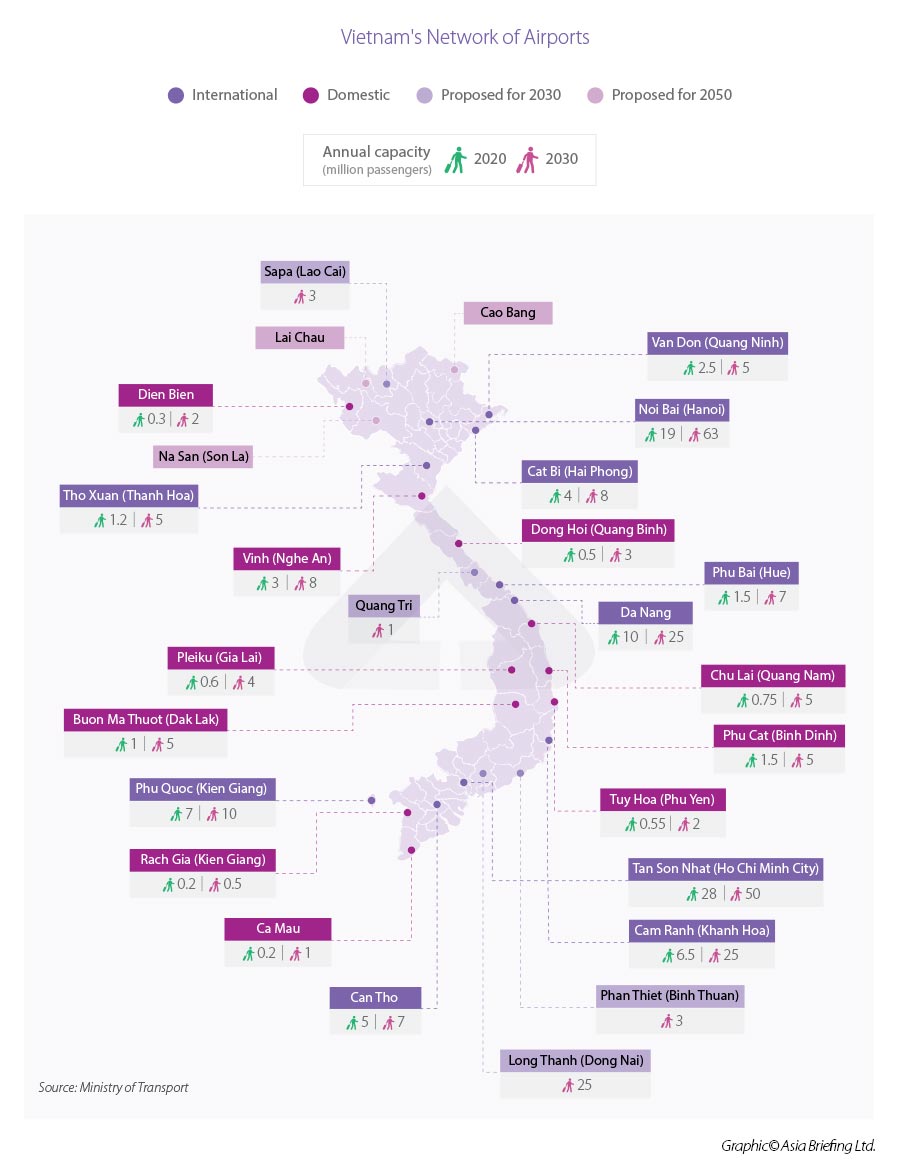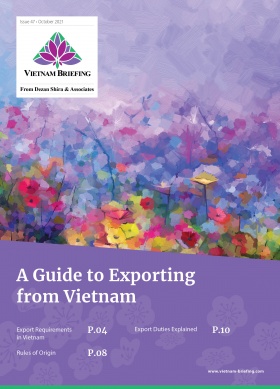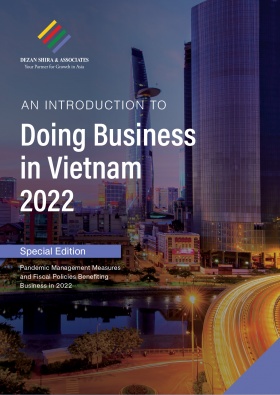Vietnam’s Airport Infrastructure: Growing Demand Fuels Overhaul
- Vietnam’s airport infrastructure is set to undergo major expansion and upgrades in the medium to long term.
- As the pandemic hit all sectors, including government revenue and foreign capital, upgradation of Vietnam’s airports will need around US$18 billion by 2030.
- Vietnam Briefing looks at Vietnam’s current airport infrastructure including future plans by the government and the opportunities for investment.
Following a rapid pre-pandemic recovery in passenger numbers, the demand for airport infrastructure during the next five years is expected to be twice of what it was in the past five years.
According to the International Air Transport Association (IATA), Vietnam is the world’s fifth fastest-growing aviation market and is forecast to cater to 150 million passengers by 2035.
The country’s Airports Corporation of Vietnam (ACV) which manages civilian airports, reports that over VND 25 trillion (US$1 billion) has been invested in expanding airport infrastructure over the past five years to facilitate passenger and cargo growth, but it will need around VND 120 trillion (US$5.2 billion) from 2021 to 2025 to complete infrastructure projects.
From 2020 to 2030, the civil regulatory body Civil Aviation Authority of Vietnam (CAAV) estimates the average annual growth rate will reach 7.5 percent to 8.5 percent for passengers and 8.4 percent to 9.7 percent for freight traffic.
By 2030, passenger air traffic is expected to reach 280 million per year and freight traffic is forecast to reach 6.8 million per year while the designed capacity of airports will reach 308 million passengers per year and 7.5 million tons of cargo per year.
In order to respond to the growing demand, Vietnam is making large investments in airport construction and upgrades, air traffic service enhancements, aircraft maintenance, overhaul capacity, and service development.
Nonetheless, there are questions about the selection of infrastructure projects, their location, and whether traffic forecasts have been exaggerated. There are also concerns about financial sources and investment and operating experience.
Vietnam Briefing highlights Vietnam’s airport infrastructure, undergoing plans as well as its objective towards foreign investment in the aviation sector so that investors can make an informed choice.
Vietnam’s airport capacity
Vietnam has 22 airports, of which 10 are international and 12 are domestic.
Major airports in Vietnam include Ho Chi Minh City’s Tan Son Nhat International Airport, the capital Hanoi’s Noi Bai International Airport, Da Nang International Airport, Nha Trang’s Cam Ranh International Airport, Phu Quoc International Airport, and Hai Phong’s Cat Bi International Airport.
The busiest and most important airport in the North is Noi Bai, located around 35km to the north of the capital. Despite having a designed capacity of only nine million, it is the largest in the country in terms of cargo transport and capacity, serving almost 30 million passengers in 2019.
In the Central region, Danang International Airport is the largest airport with two runways and traffic connectivity. The airport can serve six million passengers per year.
The biggest airport in southern Vietnam, Tan Son Nhat International Airport, is located around 7km to the north of the city center. It was the 25th busiest airport in the world in 2020, serving over 41 million passengers in 2019. Additionally, the airport accounts for nearly two-thirds of international arrivals for the whole country.
While Vietnam has plenty of airports nationwide, they are constantly overloaded with the real number of passengers and cargo exceeding their designed capacity. At the same time, the quality of airport infrastructure also varies from region to region.
Government proposal and airport development
Vietnam is looking to spend VND 400 trillion (US$17.65 billion) on the development of airports nationwide from now until 2030 with a vision to 2050, according to a proposal that the Ministry of Transport (MoT) has submitted to the government.
Anticipated airport infrastructure investments, upgrades, and expansions between 2021-2030 are as follows:
- Phase 1 construction (2021-2025) of Long Thanh International Airport valued at US$4.72 billion including a 4km long and 75m wide runway, a taxiway, an apron system, a passenger terminal, a 1.2-million-ton cargo terminal as well as an air traffic control tower;
- US$482.6 million investment in T3 Terminal at Tan Son Nhat airport (2021-2023);
- Estimated VND 4.98 trillion (US$218 million) worth investment plan in T3 terminal at Noi Bai International Airport and T2 expansion;
- The expansion of the T3 terminal at Da Nang airport;
- US$65 million runway and taxiway upgrades in Dien Bien Phu airport;
- VND 1.3 trillion (US$57 million) of investment to upgrade Quang Binh province’s Dong Hoi into an international airport, with a new terminal and an expanded apron, bringing its service capacity from the current 500,000 passengers per year to three million;
- VND 2.3 trillion (US$100 million) at Con Dao airport to bring its capacity to two million a year by expanding its runway and adding three more new taxiways.
- New construction of Phan Thiet, Sa Pa, Quang Tri, and Lai Chau airports.
According to the CAAV, the country’s top priorities feature Noi Bai, Tan Son Nhat, and the under-construction Long Thanh airport in Dong Nai Province, which will be Ho Chi Minh City’s new airport eventually replacing Tan Son Nhat.
In addition, 22 other airports across the country are planned to receive major upgrades while six new airports are to be built to bring a combined capacity to 278 million passengers a year, ensuring that 95 percent of the population can access airports within 100km.
The plan also put great emphasis on the expansion and construction of airports in remote, mountainous, and island areas, such as Dien Bien, Con Dao island, Sa Pa, and Pleiku.
By 2050, the country expects to have 29 airports in total, including 14 international and 15 domestic ones with one more airport being built in southeast Hanoi.
Public-private partnerships (PPPs) will be maximized for the delivery of the new airports, except for those of national significance and strategic military and security and those in border and island areas, which will be invested using the State capital.
The MoT also proposes the amendment and supplement of relevant legal provisions and regulations to facilitate the involvement of private investment with the local government being the public sector partner.
Long Thanh Airport: International aviation hub
The proposed Long Thanh International Airport will be located around 40km to the east of Ho Chi Minh City. The airport is designed and constructed to match the 4F standard (the highest airport class), with a total area surface of 5,000 meters square and another 25,000 meters square for the surrounding infrastructure.
The airport will have four terminals and four runways and in its final phase, the airport will be capable of serving 100 million passengers and 5 million tons of cargo every year by 2040.
Once completed, it will contribute 3 to 5 percent of Vietnam’s GDP and serve as an important international hub, connecting Vietnam with other countries.
The first phase of the airport is expected to be completed by September 2025.
Opportunities for foreign investors in the aviation sector
Since 2020, under the Comprehensive and Progressive Agreement for Trans-Pacific Partnership (CPTPP), Vietnam has permitted foreign investment in the aviation sector, including local and international air services, through capital contributions or stake acquisitions.
Under regulations on the conditional business lines in the aviation sector, effective from January 1, 2020, Vietnam has raised the foreign ownership cap in domestic air carriers to 34 percent from 30 percent.
The investment, however, will have to meet certain restrictions, including a 30 percent cap on foreign ownership in an airline and some regulations on the legal representatives of such airline companies.
Until recently, Vietnam has been working on a scheme to attract private investment in airport projects in the future. As per Document No.1061/VPCP-CP dated February 18, the Prime Minister asked the MoT to quicken the scheme on attracting private investment in airport infrastructure.
The scheme expects to further relax policies regarding the cap on foreign ownership as well as the minimum capital requirement for aviation enterprises. If properly regulated, this can help make the aviation sector more appealing to foreign investors.
For now, foreign investors can invest in add-on services at airports. As per the Decree 92/2016/ND-CP, later replaced by Decree 89/2016/ND-CP in 2020, foreign companies can invest in ground handling services, food and beverage services, maintenance, repair and overhaul services (MRO), and aviation petrol as long as their investment shall not exceed 30 percent of the total capital plus the minimum capital for these service businesses shall be VND 30 billion or US$1.3 million at least.
However, this appears to be not as attractive to investors when compared to Vietnam’s neighbors such as Thailand and Malaysia where the cap on foreign investment for these services is at 49 percent and 45 percent, respectively.
More recently, the government issued Decree No 05/2021/ND-CP (Decree 5) which replaces Decree No 102. Decree 5 which came into effect on March 10, 2021 guides the management and operation of airports in Vietnam. The Decree also sets the framework for private investment in airports in the future.
PPP models for aviation infrastructure underway
In January 2021, the CAAV submitted proposals to the MoT for PPP airport development and private investment in aviation service facilities at airports managed by ACV. The PPP proposals cover the development of six airports at Dong Hoi, Rach Gia, Ca Mau, Sa Pa, Lai Chau, and Quang Tri.
A build-operate-transfer (BOT) PPP model is currently being used at Dong Hoi as a pilot project, from 2021 to 2025. A similar model has already been applied to the development of Vietnam’s first private airport – Van Don International Airport by Vietnamese conglomerate Sun Group.
A PPP model is also being built in the central province of Quang Tri with an estimated cost of US$257 million. The domestic airport, located in Gio Linh district with a total area surface of 265 hectares expects to cater to one million passengers and 3,100 tons of cargo annually.
For now, passengers heading to Quang Tri have to fly to Thua Thien – Hue or Quang Binh province, both 100km away; thus the airport will help shorten travel time for passengers and freight.
As per Decision 236/QD-TTg, on the planning of airport transport from the 2020-2030 period Quang Tri airport is one of the domestic airports is on the list and expected to be put into operation.
Takeaways
The government’s support for upgrading airport infrastructure in Vietnam shows that it wants to make headway in this area. Decree 5 bodes well for foreign investors as it looks to streamline procedures on the management of airports. Despite the pandemic, Vietnam is expected to be one of 10 countries with the fastest growth in air passengers until 2040.
It is also expected that the government may amend other regulations to give local governments more authority to attract private investment. To this effect, the PPP model is likely to play a significant role in the aviation sector in Vietnam. With the right regulations and procedures, the aviation industry will be another avenue for foreign investors to enter the Vietnamese market.
About Us
Vietnam Briefing is produced by Dezan Shira & Associates. The firm assists foreign investors throughout Asia from offices across the world, including in Hanoi, Ho Chi Minh City, and Da Nang. Readers may write to vietnam@dezshira.com for more support on doing business in Vietnam.
We also maintain offices or have alliance partners assisting foreign investors in Indonesia, India, Singapore, The Philippines, Malaysia, Thailand, Italy, Germany, and the United States, in addition to practices in Bangladesh and Russia.
- Previous Article Вьетнам утверждает Правила электронной коммерции: Указ 85
- Next Article How to Invest in Vietnam’s EdTech Industry































